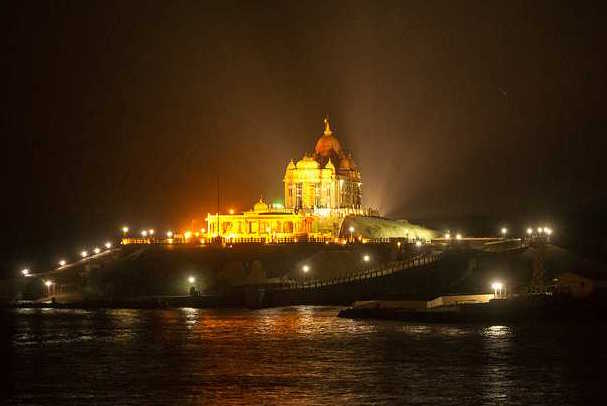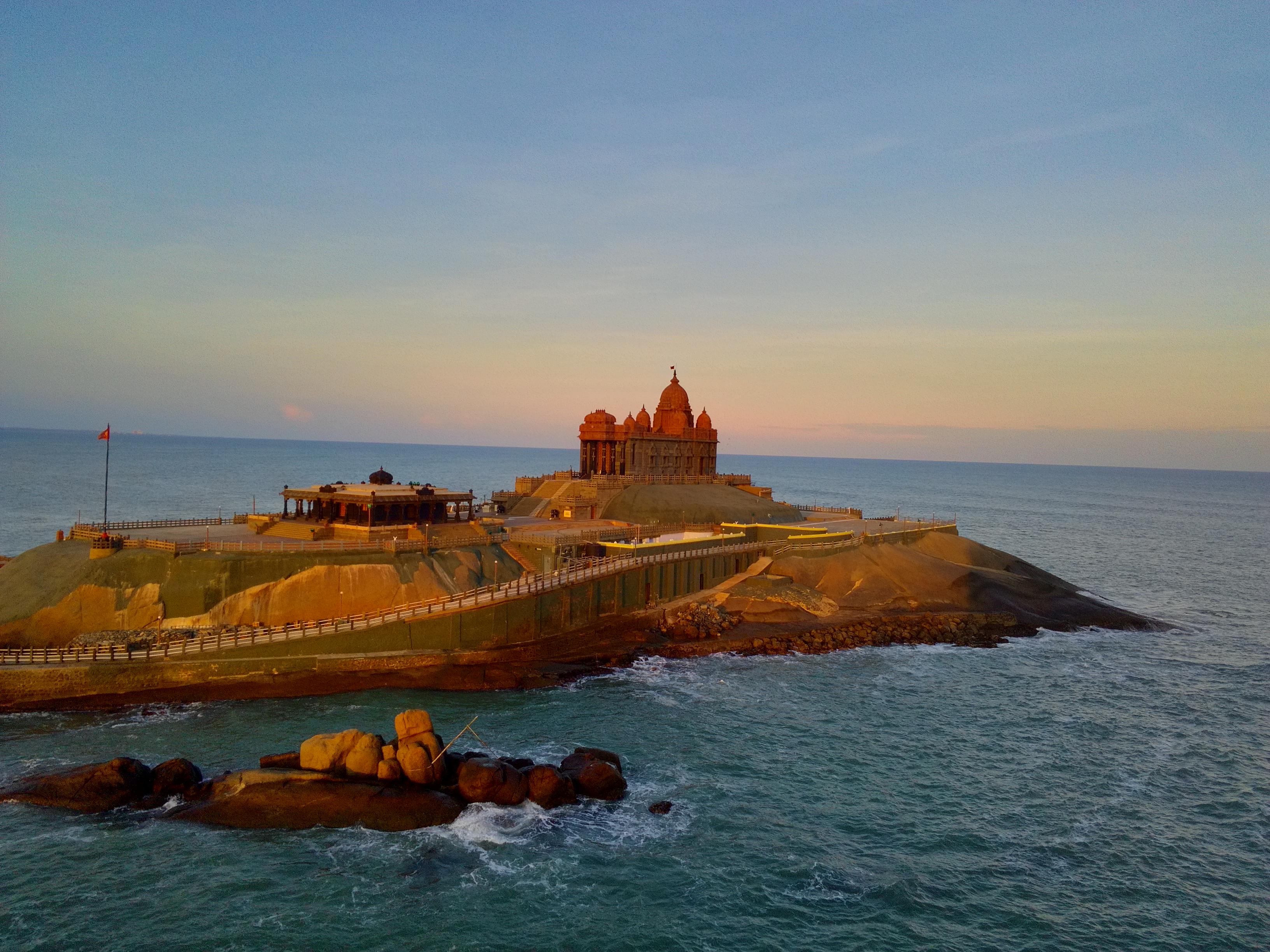The Vivekananda Rock Memorial, situated at the southernmost tip of India in Kanyakumari, is a renowned monument and tourist destination. Erected in 1970 to honor Swami Vivekananda, it stands on one of two rocks near Vavathurai, about 500 meters from the mainland. Legend holds that Swami Vivekananda achieved enlightenment on this rock, while another legend suggests it was where Goddess Kanyakumari (Parvathi) performed penance for Lord Shiva. The memorial includes a meditation hall named Dhyana Mandapam, designed with elements of various Indian temple architectures. Positioned amidst the convergence of the Bay of Bengal, the Indian Ocean, and the Arabian Sea, the rocks offer a picturesque view of the Laccadive Sea. Comprising the Vivekananda Mandapam and the Shripada Mandapam, this memorial attracts visitors from far and wide.

In January 1962, during Swami Vivekananda’s birth centenary, the Kanyakumari Committee formed to establish a memorial on the rock and a pedestrian bridge leading to it. Simultaneously, the Ramakrishna Mission in Madras also initiated plans for the memorial. However, this initiative was met with opposition from local Catholic fishermen, who erected a large Cross on the rock, sparking protests from Hindus who considered it a sacred site. A judicial inquiry affirmed the rock as Vivekananda Rock, leading to the Cross’s removal. Eventually, the government declared the rock a prohibited area, permitting only a tablet commemorating Vivekananda’s association with the site, installed in January 1963.
Swami Vivekananda, a revered Hindu philosopher-saint, holds a significant place in Indian history for his profound teachings and spiritual journey. One of the most pivotal moments in his life occurred in 1892 when he swam to a rocky islet off the southern tip of mainland India, near Kanyakumari. This islet, known as the Vivekananda Rock, became the site of his meditation for three days and nights, where he is believed to have attained enlightenment. Situated at the confluence of the Indian Ocean, the Arabian Sea, and the Bay of Bengal, this sacred rock symbolizes the convergence of spiritual energies.

Modi’s Pilgrimage: Honoring Vivekananda’s Legacy in Political Culmination
Fast forward to the present day, Prime Minister Narendra Modi announced his intention to visit and meditate at the Vivekananda Rock Memorial in Kanyakumari, Tamil Nadu. Scheduled from May 30 to June 1, this visit marks the culmination of the Bharatiya Janata Party’s (BJP) Lok Sabha election campaign. For Modi, this pilgrimage is reminiscent of his previous visit to Uttarakhand’s Kedarnath shrine at the end of the 2019 election campaign, where he engaged in a 15-hour-long solitary meditation, known as ekantvaas.
Modi’s reverence for Swami Vivekananda as a role model is well-documented. As a young man, he was a member of the Ramakrishna Mission, a spiritual and philanthropic organization founded by Swami Vivekananda. Speaking at the Mission’s 125th anniversary celebrations, Modi lauded Swami Vivekananda’s grand vision for India and expressed his commitment to fulfilling this vision.
Our beloved PM Shri @narendramodi ji will be meditating for three days at the Vivekananda Rock Memorial, Kanyakumari. The memorial has lot of history behind it & faced many hurdles when it was built. Let us look at the background and the struggles it has to encounter. pic.twitter.com/sV690LP65y
— 𑀓𑀺𑀭𑀼𑀱𑁆𑀡𑀷𑁆 🇮🇳 (@tskrishnan) May 30, 2024
The selection of the Vivekananda Rock for Modi’s meditative retreat holds profound significance, particularly in light of his strategic outreach to the southern states during the Lok Sabha campaign. Over the past few years, Modi has intensified his efforts to engage with the southern electorate, recognizing the region’s political importance. With Tamil Nadu alone accounting for 39 parliamentary seats, the South plays a crucial role in shaping the national political landscape.
Modi’s visits to the southern states reflect his ambition to expand the Bharatiya Janata Party’s presence in the region. In an interview, he expressed confidence in the BJP’s growing influence, emphasizing the party’s increased mind-share, vote share, and seat share in the South. By paying homage to Swami Vivekananda at the Vivekananda Rock, Modi seeks to resonate with the spiritual and cultural ethos of the region while reinforcing his commitment to the nation’s development.
The Vivekananda Rock Memorial stands as a testament to the enduring legacy of Swami Vivekananda and his profound impact on Indian society. Built in 1970 by the Vivekananda Rock Memorial Committee, led by RSS activist Eknath Ranade, the memorial commemorates the site of Swami Vivekananda’s enlightenment. President V V Giri formally inaugurated the memorial, affirming its significance as a sacred place of spiritual awakening.
As Prime Minister Modi embarks on his spiritual journey to the Vivekananda Rock, he not only pays homage to a revered spiritual leader but also underscores the cultural and philosophical heritage of India. His visit serves as a poignant reminder of the enduring influence of Swami Vivekananda’s teachings and his vision for a prosperous and harmonious nation. In the serene surroundings of Kanyakumari, Modi seeks inspiration and guidance, drawing strength from the timeless wisdom of Swami Vivekananda as he charts the course for India’s future.
READ MORE : PM Modi’s Spiritual Retreat In Kanyakumari & India’s Rafale Deal Talks with France: What To Expect Today

















